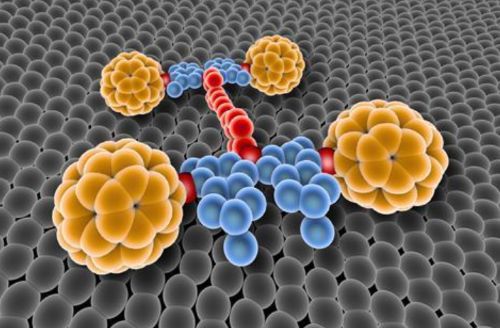

If architecture has always been about shaping space to human need, nanoarchitectonics suggests that the future of that shaping may begin with a hole a million times smaller than the head of a pin.

By Matthew A. McIntosh
Public Historian
Brewminate
A Revolution at the Atomic Scale
Architecture has always been a dialogue between vision and material. Stone cathedrals rose because masons mastered weight and span. Skyscrapers pierced the clouds because engineers learned to harness steel and concrete. Today, a new frontier is emerging that pushes this dialogue far beneath the visible eye. Nanoarchitectonics, a discipline that manipulates matter at the atomic and molecular scale, is being positioned as the next transformation in how buildings are imagined, designed, and constructed.
The term was coined by Japanese researcher Masakazu Aono, who envisioned a unifying approach where nanotechnology, supramolecular chemistry, and materials science converge to create functionally precise structures. Applied to construction, nanoarchitectonics promises building materials that are not only stronger and lighter, but also more responsive to environmental demands. The ambitions are sweeping: buildings that breathe, facades that heal, and infrastructures designed with the precision of a molecule.
From Laboratory Insight to Structural Innovation
The promise of nanoarchitectonics in construction lies in its ability to alter the very foundation of building materials. Concrete, the most widely used human-made substance on earth, produces nearly 8 percent of global carbon emissions. Through nanoarchitectonic approaches, researchers are reengineering its microstructure with nano-silica to improve strength and durability while reducing permeability.
Steel, another cornerstone of modern infrastructure, is being reimagined through nano-coatings that protect against corrosion, an issue that costs billions each year. By altering properties at the nanoscale, engineers may dramatically extend the lifespan of bridges, tunnels, and high-rises. These are not mere enhancements. They represent the possibility of structures whose resilience is designed atom by atom.
The Yamauchi-Asakura Laboratory: Architects of the Invisible
The frontier of this work is exemplified by the Yamauchi-Asakura Laboratory at Nagoya University. Led by Professor Yusuke Yamauchi, one of Japan’s most recognized materials scientists, and Associate Professor Yusuke Asakura, the lab focuses on designing nanospaces inside inorganic materials to maximize performance for clean technology applications.
Their technique, known as “templating,” resembles making a sponge with perfectly arranged holes. By introducing template molecules as removable molds, they carve networks of nanoscale tunnels and chambers inside metals and carbon. Once the molds are removed, the remaining material possesses highly controlled porosity. These internal structures expand surface area, improve conductivity, and enhance chemical reactivity, providing advantages in applications as diverse as batteries, hydrogen fuel cells, and pollution sensors.
Professor Yamauchi, a Clarivate Highly Cited Researcher for eight consecutive years, has pushed the field with breakthroughs that make advanced materials practical. His team has engineered nanoporous metals that use 90 percent less platinum while achieving superior catalytic performance, offering a path to cheaper, more efficient hydrogen energy systems. In 2023, the lab created a “high-entropy alloy” catalyst by combining five metals into a sponge-like nanoporous structure, producing hydrogen more effectively across acidic, neutral, and basic environments.
The lab has also ventured into environmental protection. In 2024, researchers developed a silver metal foam to trap microplastics from waterways. Acting like a microscopic filter, the foam captured plastics that were then identified using artificial intelligence. As Yamauchi put it, “You can simply dip the foam into a river and get results.” The innovation could democratize pollution monitoring by providing a simple, low-cost method available beyond specialized laboratories.
Such achievements highlight how nanoarchitectonics is not just a theoretical framework but a growing body of applied research that bridges energy, environment, and engineering.
Sustainability and the Politics of Scale
The urgency of climate change casts a long shadow over construction. Cities demand new housing and infrastructure, yet every ton of cement poured and every beam of steel forged adds to global carbon debt. Nanoarchitectonics, if industrialized successfully, could relieve this contradiction by reducing waste, extending material life, and enabling the use of renewable inputs.
But questions remain. Can developing nations, where construction growth is steepest, afford materials produced through nanoscale engineering? Will patents and licensing tie the benefits to a handful of multinational firms? Professor Yamauchi has long emphasized academia–industry partnerships as essential for scaling these discoveries, yet the uneven economics of global construction could complicate their adoption. Sustainability at the nanoscale still must contend with sustainability at the civic and social scale.
Cultural Imagination and Architectural Futures
Beyond materials, nanoarchitectonics compels us to rethink what architecture itself can be. Imagine a school whose walls regulate light and air through nanostructured sensors, or a hospital where surfaces destroy pathogens instantly. These examples illustrate not only new technical capabilities but also fresh cultural imaginations of safety, efficiency, and health.
History offers parallels. The arrival of glass and steel in the 19th century reshaped cities, not only structurally but symbolically, reflecting industrial optimism. Today, nanoarchitectonics suggests a future where construction becomes inseparable from ecology and health, embedding care into the very walls that shelter us.
Skepticism remains prudent. Every technological revolution in construction has carried risks hidden beneath its promise. Asbestos once symbolized progress before becoming a hazard. Plastics offered versatility before generating global waste crises. Nanoarchitectonics will need careful governance and transparency to avoid similar pitfalls.
Conclusion: Building With Atoms, Dreaming in Cities
The story of nanoarchitectonics in construction is still being written. It is a story of laboratories like Nagoya’s, where scientists act as architects of the invisible, shaping sponges of metal that could transform how we power cities and clean rivers. It is also a story of political choices, economic realities, and cultural aspirations that will decide whether atomic-scale breakthroughs translate into civic-scale revolutions. If architecture has always been about shaping space to human need, nanoarchitectonics suggests that the future of that shaping may begin with a hole a million times smaller than the head of a pin. The challenge will be moving from the elegance of the laboratory to the messiness of real construction sites. Whether this technology defines the next century of building or remains an unrealized vision will depend on how societies negotiate the line between possibility and responsibility.
Originally published by Brewminate, 09.09.2025, under the terms of a Creative Commons Attribution-NonCommercial-NoDerivatives 4.0 International license.


